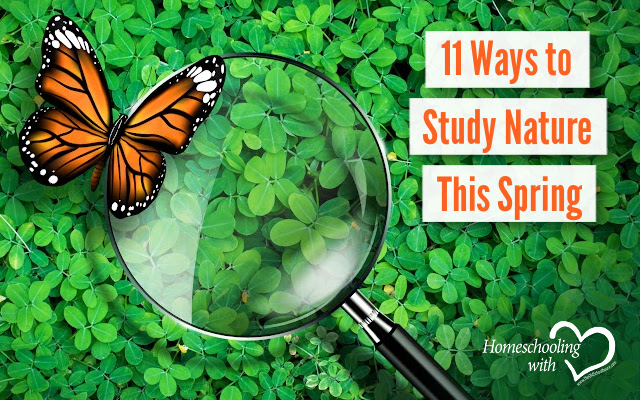11 Ways to Study Nature This Spring


Spring is in the air, a perfect time to encourage your kids to get outside and explore. When you have been cooped up indoors for months it can be trying on your nerves. God has created sunshine to have so many benefits including providing us with our Vitamin D. As homeschooling parents, it is tempting to stay indoors and clean house when we see all that needs to be done, which is oftentimes needed this time of year, but getting outdoors is needed even more! What better way to get the sunshine you and your kids need than to make it an educational experience? Here are fifteen springtastic ways to study nature this spring with kids of all ages.
- Grow plants in plastic cups, monitoring each plant’s progress.
Find a variety of seeds that you can begin indoors and transplant outside once you see significant growth. Sunflower seeds, tomato seeds, and pepper seeds are great ones to start with. Create a chart and see which seeds grow quicker. You can even pull out a nature journal and have your child draw the plant throughout the different stages. - Press flowers and create a bookmark with their scientific names. Kids love pressing flowers! And they last for years. This is an excellent keepsake to make and keep in your home for years to come. Creating a bookmark with pressed flowers is simple with the use of contact paper. Of course, you can use them to make ornaments, Mother’s Day cards, or anything your imagination can dream up! Including their scientific names is the icing on the cake.
- Make ink from plants local to your area and create a tie-dyed shirt from them. My kids thought this was the best thing since sliced bread. They loved breaking open black walnuts, prickly pears, and other plants local to our area.
- Study climbing plants. Which climbing plants are found in your neck of the woods? Honeysuckle? Passion flower? Ivy? Study these plants by marking the speed of growth.
- Create a topographic map of your area. Hands-on learners will love getting their hands dirty creating a papier-mâché topographic map. Use acrylic paints, shredded newspaper, and glue. Your children will be able to visually see the layout of the land where you live which can be helpful in so many practical ways.
- Make a list of all of the flowers growing on your property. Some may be considered weeds. Label them as you may, flowers are flowers. Inch your way through your property and every flower counts (yes, even dandelions and clovers!).
- Dig up five bugs in the dirt and study them. Dig deep (or possibly not deep at all) until you find five different types of bugs. Be sure to fill in your hole, making it look like you were never there. Take the bugs into some light and study under a magnifying glass. Take pictures, draw pictures, or create charts!
- Make a list of all of the birds local to your area. Take a drive to a local lake, pond, or park. On the way, you might be surprised as to what you see. Sometimes when we slow down and observe our surroundings, we find things that we never paid attention to before. Are there eagles, hawks, or falcons in your area? Have vultures huddled around some roadkill? Look for the birds of prey and then once you reach your destination get out your binoculars and seek out smaller songbirds. You might even consider waking up early in the morning and seeing what you can spy in your own backyard. (Adding some backyard treats to draw some birds in might not be a bad idea!)
- Make a rain gauge and track the rainfall in your area for a month. Sometimes, it helps to have a project that lasts a significant amount of time. It teaches perseverance, patience, and determination. It gives your child a sense of accomplishment. They set their mind to something and did it. Creating a rain gauge is fun, easy, and is exciting to watch slowly fill up!
- Find three edible plants in your area. Make sure you research this before taking the kids out on an adventure so you can guide them. You might even consider growing your own. Nasturtium is a great one. Dandelion root is excellent for tea if you have it growing locally.
- Make a necklace out of nature. Send your kids on a nature hunt and ask them to collect materials that they could make a beautiful creation out of and let them wear them for the remainder of the day.
How do you study nature in the spring?
















































